Famous American writer Henry Miller’s interest in UFOs
Antonio Huneeus | Jan 24, 2012
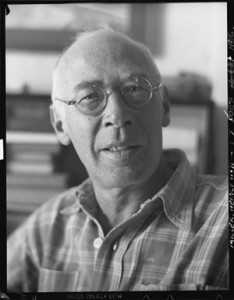
Portrait of Henry Miller
It turns out that Henry Miller (1891-1980), one of the great American
writers of the 20th century, was quite interested in UFOs and even had a
sighting in Big Sur, California. Miller is best remembered for books
like Tropic of Cancer (1934), Tropic of Capricorn (1939) and Nexus (first American edition 1965). The two Tropics
were considered so controversial because of their explicit erotic
content based on Miller’s bohemian lifestyle in Paris during the 1930s,
that they were banned in the United States as “obscene” between 1934 and
1961. Even after the ban was officially lifted in 1961, booksellers
continued to be harassed for selling Miller’s books until 1964, when the
Supreme Court declared that the sale of Tropic of Cancer was protected by the constitution.
Henry Miller is of course best known for his avant-garde literary
work, but he was also interested in a number of off-beat subjects like
the prophecies of Nostradamus, Indian mysticism and UFOs or flying
saucers. His fascination with the 16th century French prophet Michel de
Nostradamus is well documented—he is mentioned in several of Miller’s
books and letters. Miller corresponded with and even visited in 1953 Dr.
Max de Fontbrune, a well known French expert on Nostradamus in the
period right before, during and after World War Two. It was while
looking at the Miller-Nostradamus connection a while ago that I
discovered that he had been fascinated also by the UFO subject when the
so-called flying saucers first emerged in American popular culture in
the late 40s and early 50s.
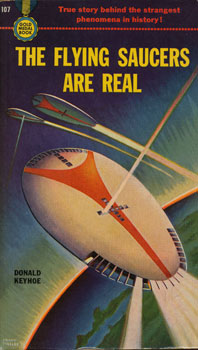
Cover
of Donald Keyhoe’s first book on flying saucers published in 1950, of
which Henry Miller became a fan.
Mary V. Dearborn writes in her 1991 book, The Happiest Man Alive – A Biography of Henry Miller,
that “Miller was also a passionate believer in UFOs, and during the
1950s he would come to believe that an invasion by aliens was imminent.
For a time he promoted a book called Flying Saucers Are Real,
by Donald Keyhoe; friends like [the British novelist Lawrence] Durrell
were merely amused…” That was Major Keyhoe’s first book published as a
paperback in 1950, which is considered with Frank Scully’s Behind the Flying Saucers
as the first two UFO books published in the USA. Keyhoe went on to
write several other books on the subject and became the influential
director of the National Committee on Aerial Phenomena (NICAP) in the
late 1950s, one of the major UFO organizations back then.
I was able to track down some of the Keyhoe references in two of Miller’s books. In The Books in My Life,
published in 1969, Miller mentions Keyhoe right in the Preface,
together with Nostradamus and other “books and authors I intend to dwell
in the future”:
And Nostradamus, Janko Lavrin, Paul Brunton, Péguy, Ouspensky’s In Search of the Miraculous, Letters from the Mahatmas, Fechner’s Life After Death, Claude Houghton’s metaphysical novels, Cyril Connolly’s Enemies of Promise (another book about books), the language of night, as Eugene Jolas calls it, Donald Keyhoe’s book on the flying saucers, cybernetics and dianetics, the importance of nonsense, the subject of resurrection and ascension, and, among other things, a recent book by Carlo Suarès (the same who wrote on Krishnamurti), entitled Le Myhe Judéo-Chrétien [The Judeo-Christian Myth].
This partial list of authors and titles gives a pretty good idea of
the range of metaphysical and occult books—what today we would call New
Age books—that interested Miller. Later on in the same book, Miller
writes: “At this point I think it important to mention the fact that
SCIENCE has just discovered the efficacy, the therapeutic efficacy, of
Love. The Sunday supplements are full of this subject. Next to
Dianetics, the Flying Saucers and Cybernetics, it is apparently the
great discovery of the age.”
In The Durrell-Miller Letters, 1935-1980, a book of his correspondence with the well known British novelist Lawrence Durrell (1912-1990), author of The Alexandria Quartet, there is a letter to Durrell from Big Sur, California, dated May 7, 1954, where Miller writes in part:
Our projects are still tentative. Everything depends on proceeds from Japan and France. And whether or not war III this Fall, which I fear. Wouldn’t leave here before September anyway, as children would still be with us till the end of August.
Mailed you book on Flying Saucers. And – the Big Sur Guide.
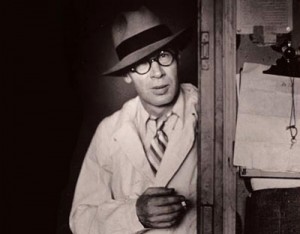
Another portrait of Henry Miller probably in the 1930s or early 1940s.
Miller’s biographer Mary Dearborn mentions also a letter from August
6, 1950 written to a friend of Miller named Robert Fink, where the
Keyhoe book is mentioned (this would have been right after publication
of The Flying Saucers Are Real by Fawcett Publications in
1950). The letter is at the University of Texas’ Miller Archives, but
unfortunately is not available online so I was unable to consult it.
Another letter to the French poet Joseph Delteil (1894-1978), a close
friend of Miller, shows that the American writer was reading more UFO
books than just Keyhoe’s. I haven’t been able to locate the letter
itself but a reference to it in the article by Karl Orend, “Reveries of a
solitary old man and his angels—Henry Miller’s unknown book and his
encounter with the magician, Joseph Delteil,” published in Nexus: The International Henry Miller Journal, 7 (Annual 2010). Orend wrote that in a letter to Delteil dated February 4, 1954, “Miller recommended Les Soucoupes Volantes ont atterri
[Flying Saucers Have Landed] by Desmond Leslie and George Adamski.
Henry was convinced that we would soon have contact with
extraterrestrials!” Although most readers probably associate this book
with Adamski’s famous account of his contact with ETs in Desert Center,
California, in 1952, the bulk of it was written by the British
aristocratic author and musician Desmond Leslie, consisting in a well
written historical overview of the UFO evidence up to that time. The
Adamski section was only the last fourth of Flying Saucers Have Landed.
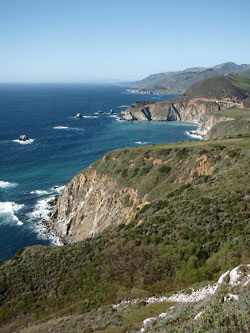
View
of the Pacific Ocean around the area where Miller lived in Big Sur,
California.
The Big Sur Guru
Before quoting Henry Miller’s own UFO sighting, it’s important to
frame it within the context of his life in Big Sur, California, in the
period of the late 40s and early 50s. Miller was a wanderer for most of
his life: he was born in New York in 1891, but began traveling as a
young man first to the West and then to Europe. His stormy life in Paris
in the 1930s inspired his Tropics and the censorship
controversy. He was in Greece in 1939 when World War Two began and made
it safely back to New York in 1940. In 1944 he moved to Big Sur, which
he called “my first real home in America,” first at Keith Evans’ cabin
in Partington Ridge in 1945, then at a shack at Anderson Creek in 1946,
and finally he was given access to Jean Page Wharton’s house with a
magnificent view of the Pacific in Partington Ridge, where he wrote many
of his famous books like Plexus and Nexus. The
atmosphere surrounding Miller in Partington Ridge was described in an
article by Mildred Edie Brady, “The New Cult of Sex and Anarchy,”
published in Harpers Magazine in April 1947. Brady wrote:
There is no design or German orderliness in the mysticism of the California anarchists. Anything goes. Since Miller’s sojourn on the coast, the bag of wonders he brought with him has even been stuffed with a number of local additions; for besides the CO’s, the salacious curious, and the young literati, there were still other visitors to Miller’s shack. His appetite for the mysterious was soon widely known and a host of dealers in occult lore came to see him: astrologers, faith healers, sexologists, and spiritualists laid their experiences in the wonderful at his feet and marveled with him over the grandeurs of the Lost Continent of Mu.
You can see here the forerunner of both the hippie culture of the
sixties and the New Age movement typical of California which blossomed
in the eighties. Miller himself wrote a book about his life in
California, Big Sur and the Oranges of Hieronymus Bosch,
published in 1957. Both the title and the covers of the American and
British editions refer to the 15th century Dutch painter Hieronymus
Bosch, whose religious paintings and particularly his triptych The Garden of Earthly Delights, is a bizarre masterpiece foreshadowing surrealism. The publisher New Directions describes Big Sur and the Oranges of Hieronymus Bosch as
one of his most appealing books… it tells the story of Miller’s life on the Big Sur, a section of California coast where he lived for fifteen years. Big Sur is the portrait of a place; one of the most colorful in the world; and of the extraordinary people Miller knew there: writers (& writers who didn’t write), mystics seeking truth in meditation (& the not-so-saintly looking for sex-cults or celebrity), sophisticated children & adult innocents; geniuses, cranks & the unclassifiable. Henry Miller writes with a buoyancy & brimming energy that are infectious. He has a fine touch for comedy. But this is also a serious book; the testament of a free spirit who has broken through the restraints & clichés of modern life to find within himself his own kind of paradise.
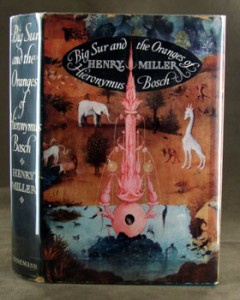
Cover
of the British edition (Heinemann, 1957) of Henry Miller’s Big Sur and
the Oranges of Hieronymus Bosch, where the UFO account was published.
Literary scholar Raoul R. Ibarguen analyzes the book in the website Henry-Miller.com:
Big Sur and the Oranges of Hieronymus Bosch (1957), one of the best of Miller’s later writings, so deviates from the cultivated “confusion” of the Paris novels as to open with two short chapters entitled “Chronological” and “Topological,” telling how Miller came to live at Big Sur and laying out the human, geological, and natural history of the place. The abrupt change indicates not so much a redirection of Miller’s formal efforts as a repudiation of formal innovation per se.
The Big Sur UFO sightings
In Part 2 of the Big Sur book, “Peace and Solitude: a
Potpourri,” Henry Miller describes in some detail his own UFO sighting
as well as the emergence of the flying saucers among the off-beat
literati and spiritual seekers hanging around the great writer. Here is
the passage in full:
Just the same, it was at Anderson Creek that the first flying saucer made its appearance in Big Sur. The chap who told me the story said it happened early one morning. In shape it was more like a dirigible than the lamp-shade variety. It hovered close to shore, plainly visible, took off and returned two more times. Shortly after this two more sightings, one at dawn, another at twilight, were made by people staying at the sulphur baths. Then one day my friend Walker Winslow woke me up out of a sound sleep to witness a strange phenomenon just above the horizon, looking seaward. We observed the strange activity of what seemed like twin stars gyrating about an invisible pivot for about twenty minutes, after which the light grew too strong and it faded out. But it was reported—as a saucer phenomenon—next day by the government station along the coast. Soon thereafter a number of friends reported saucers, lights that followed their cars, and so on. None of them were drunks or dope fiends. Some of them were, or had been, downright sceptics about “this saucer business.” One of the most vivid accounts was given by Eric Barker, then living at the Hunt Ranch near the Little Sur. In broad daylight, about four in the afternoon, he saw six small disks flying above his head at a brisk but not phenomenal speed. They were going out to sea. Eric swore that they were not buzzards, balloons or meteorites. Moreover, he is definitely not the type that “sees things.” A few weeks later a visitor from Carmel was witness to a similar phenomenon. She was so moved by the sight that she became almost hysterical. Tom Sawyer and Dorothy Weston reported lights dancing in front of their car on the way home from Monterey one night. The performance continued for over five minutes and was repeated subsequently. Ephraim Doner, whose two feet are definitely planted in the earth, was escorted for over five miles by mysterious brilliant-colored lights one evening on leaving our home. His wife and daughter were with him and corroborated his words.
So there you have it: the intersection of American literature and
ufology; or when one of the great writers of the 20th century became a
ufologist, describing both his own sighting and the experiences of close
friends and acquaintances around the Big Sur area. In all my years as a
ufologist I never recall coming across a single reference in the UFO
literature to Henry Miller’s interest in the subject, until now.
Unfortunately, Miller didn’t provide exact dates, but from the general
time frame of the book it should be more or less within the 1947-1953
period. Miller said his own sighting had been reported “by the
government station along the coast,” so presumably there is a record of
it somewhere in the Project Blue Book files or their predecessors
Projects Sign and Grudge. Some of the other cases he mentions of objects
following cars and the like are very interesting. There is a final
“flying saucer” reference in Miller’s Big Sur book, although it is more of a sociological nature but still worth quoting:
The air is full of theories about the new order, the new dispensation. Marvelous pictures are painted of the period just around the bend, when we of this earth will see the end of making war, when atomic energy will be utilized for the benefit of all mankind. But no one acts as if this glorious age which is dawning were an imminent, wholly realizable, thoroughly practicable one, indeed the only viable one. It is a beautiful subject for discussion at cocktail hour, when all the current topics have been chewed to a frazzle. Usually a rider to the flying saucer business. Or to Swami So-and-So’s latest book.
A UFO in a painting by Bosch?
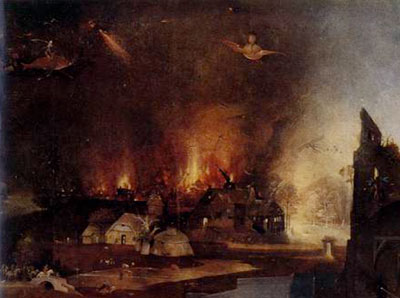
Detail
with possible UFO of Hieronymus Bosch’s Temptations of St Anthony, at
the National Museum of Old Art in Lisbon. (credit: Web Gallery of Art)
As a final homage to Henry Miller’s interest in UFOs, we are reproducing a detail from the triptych of the Temptation of Saint Anthony
by Hieronymus Bosch, preserved at the National Museum of Old Art in
Lisbon. On the upper left corner of the centerpiece of the painting by
the Dutch master, dated 1505-06, there are a number of strange things in
the dark sky. Some are purely fantastic—a landmark of Hieronymus
Bosch—but the one in the middle emitting a beam of light curiously
resembles a UFO. You can see the whole painting at the Web Gallery of Art.
I am not claiming that this is based on a real UFO incident, like those
possibly depicted in other Renaissance paintings and broadsheets, since
Bosch was the ultimate master of dreamlike, fantastic and surreal
imagery, but it provided a worthwhile conclusion to this piece.


No comments:
Post a Comment